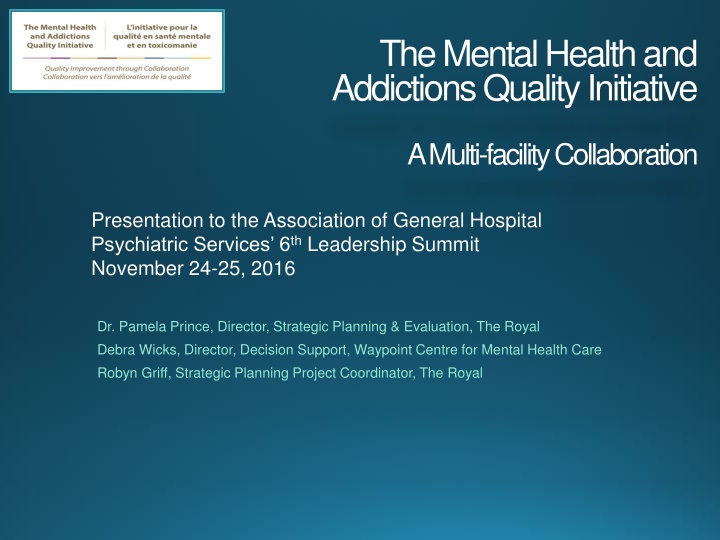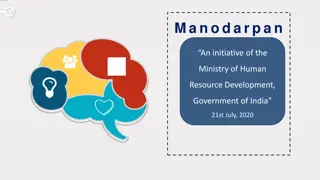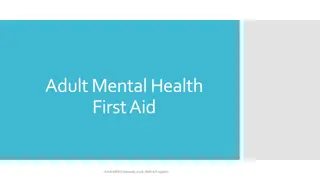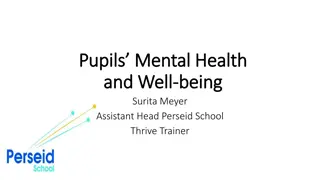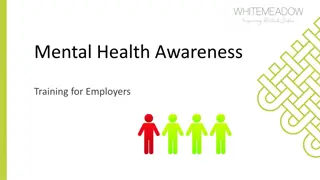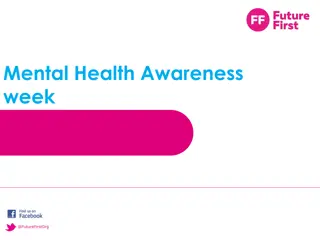The Mental Health & Addictions Quality Initiative Presentation
The Mental Health & Addictions Quality Initiative (MHAQI) is a collaborative project among mental health hospitals in Ontario to define quality indicators, compare performance, and share best practices. The initiative aims to measure performance in key domains such as client experience, outcomes, safety, and fiscal responsibility, promoting transparency and accountability within the facilities.
Download Presentation

Please find below an Image/Link to download the presentation.
The content on the website is provided AS IS for your information and personal use only. It may not be sold, licensed, or shared on other websites without obtaining consent from the author.If you encounter any issues during the download, it is possible that the publisher has removed the file from their server.
You are allowed to download the files provided on this website for personal or commercial use, subject to the condition that they are used lawfully. All files are the property of their respective owners.
The content on the website is provided AS IS for your information and personal use only. It may not be sold, licensed, or shared on other websites without obtaining consent from the author.
E N D
Presentation Transcript
The Mental Health and Addictions Quality Initiative A Multi-facility Collaboration Presentation to the Association of General Hospital Psychiatric Services 6th Leadership Summit November 24-25, 2016 Dr. Pamela Prince, Director, Strategic Planning & Evaluation, The Royal Debra Wicks, Director, Decision Support, Waypoint Centre for Mental Health Care Robyn Griff, Strategic Planning Project Coordinator, The Royal
The Mental Health & Addictions Quality Initiative (MHAQI) Began in 2011 as a peer comparison project among four specialty mental health hospitals in Ontario. It is a unique example of mental health and addictions hospitals coming together to define quality indicators and share results in order to develop common processes and quality improvement initiatives. CAMH (Centre for Addiction & Mental Health): Toronto 529 Inpatient Beds, 4,000 IP admissions Ontario Shores: Whitby 339 beds, 595 IP admissions The Royal: Ottawa 2 sites, 439 beds, 1790 IP admissions Waypoint: Penetanguishene 2 sites (1 forensic), 312 inpatient beds,1,079 IP admissions
Objectives Develop a standardized approach to measuring performance in mental health care in key domains of: Client experience Complexity Access Outcomes Client & Staff Safety Human Resources Fiscal Responsibility Compare performance among facilities Publically demonstrate accountability and transparency Share best practices among hospitals and across departments Highlight the work of specialty mental health facilities
Indicator Selection Criteria Alignment with provincial and national initiatives Impact on health system Understandable - must be meaningful from a public perspective Standardization: common and clear definitions across organizations Valid and reliable Timely Actionable Availability of data 4
The Role of The Resident Assessment Instrument for Mental Health (RAI-MH) Implementing a standard set of indicators that includes the RAI-MH has been instrumental in facilitating consistency in quality measurement: Offered an existing data system Offered standardized definitions for a number of indicators Offered opportunity the develop new indicators from existing data elements Data quality collective resolution over time 5
MHAQI Indicators (2016-17) Indicator Rationale Domain # of reasons for admission Assumption that clients with more than one reason for admission are more complex. Similarly with # of psychiatric and medical diagnoses; the discharge assessment was chosen because the diagnostic information was thought to be more complete and reliable than at admission. Source: RAI- MH, CIHI # of psychiatric diagnoses at discharge Client Complexity # of medical diagnoses at discharge Change Self-Care Index and Overall Change in Care Needs between admission and discharge Two measures of the effectiveness of care. Self-Care Index and Overall Change in Care Needs were chosen because of their applicability across diverse diagnostic groups. Source: RAI-MH, CIHI Outcomes Readmission rate within 30 days of discharge to Same facility and Any Facility A standard proxy indicator of outcomes in many hospital settings, to ensure that clients are not being discharged too early. Source: Internal data and CIHI % of ALC days Access to services is a major issue in mental health, where it is common to have clients who have been hospitalized for many years because of the lack of appropriate supportive housing. Inability to discharge patients to appropriate levels of care has a negative impact on the number of beds available for new admissions. Source: Internal data Client Access Wait Times In Progress
Domain Indicator Rationale Prevalence of physical restraint, acute control medication use and seclusion at admission Restraint of clients is a safety issue in both physical and emotional terms. All four hospitals have restraint reduction initiatives. Source: RAI-MH, CIHI Client Safety % ULOA days Unauthorized leave of absence (ULOA) is a risk to client safety, as well as, to a lesser degree, to the public. Source: Internal data % of admissions with completed medication reconciliation Reconciliation of patient medication on admission is a requirement of Accreditation Canada, and a key performance measure across hospitals of all types. Source: Internal data Medication Incidents Medication incidents are errors or potential errors with medication that may cause or could lead to inappropriate medication use or patient harm. Source: Internal data Absenteeism rate Can be a reflection of employee engagement. Source: Internal data HR Indicator % positive score on the Employee Engagement Survey "Engagement" subscale Employee Engagement Survey Source: NRC Picker Canada Employee Engagement # of Balanced Budgets in last 5 years Fiscal responsibility is an area of increasing concern for hospitals. This indicator was chosen over a financial ratio as more relevant and understandable to the public. Source: Internal data Fiscal Responsibility
Expansion and Growth Over the past five years, a number of facilities have joined the MHAQI at the suggestion of their LHINs. This enables comparisons across organization and LHINs using the same Mental Health measures. 2012: Contracted with CIHI to facilitate central data collection and generate quarterly scorecards 13 Facilities on-boarded 2013 - 2014: Publication, The Mental Health and Addictions Quality Initiative: Collaboration in Public Reporting and Quality Improvement (Prince & Willett) Standardized reporting for Medication Reconciliation and Incidents Joint Partner with the Mental Health Commission in the International Initiative for Mental Health Leadership Indicator Project (IIMHL) 18 facilities on-boarded
Expansion and Growth (cont) 2015 present: 2-year Quality improvement initiative Restraint reduction and prevention Access to Care Initiative (Ontario s Mental Health and Addictions Strategy Funding) MHAQI scorecard - Basis for a current provincial initiative to implement MHA indicators across the sector 20 facilities on-boarded
How Member Facilities are Sharing the Scorecard (excerpt of MHAQI Member Survey, October, 2015): 42% present the MHAQI Scorecard to their Board 83% review the MHAQI Scorecard at the Senior Management Team Level 33% review the MHAQI Scorecard at the Program Level Practice Changes: Enhanced networking amongst peer facilities across Ontario in multiple departments (e.g., staff and client safety, finance, Human Resources, etc.) Improved data quality and understanding/interpretation of indicators Internal quality improvement initiatives resulting from sharing results and quarterly meetings
Where are we now? Collaboration Across Care Settings Canadian Mental Health Association Ontario/ Addictions and Mental Health Ontario Health Quality Ontario - Quality Standards (Depression, Schizophrenia, Dementia) Client Experience and Outcomes Adoption of Ontario Perception of Care for Mental Health, (OPOC-MH) by community services and 4 specialty hospitals provides opportunity for evaluation across the MHA sector Multi-facility validation of the Waypoint Index of Clinical Improvement (WICI) - RAI-MH based outcome measure developed by Dr. H. Barbaree et al. Access to Care The MHAQI has partnered with the Ontario Ministry of Health and Long Term Care to develop and pilot access and wait time indicators (Access to Clinician within 7 days of Discharge; Youth access to psychiatry with 14 days of referral; Access to CBT) z 13
Thank You Contact: Robyn Griff, MHAQI Coordinator Robyn.griff@theroyal.ca Pamela N. Prince, PhD Pamela.Prince@theroyal.ca Dreba Wicks dwicks@waypointcentre.ca
